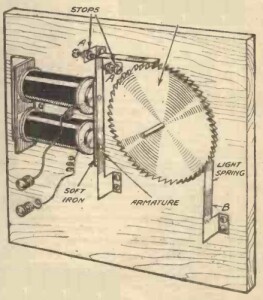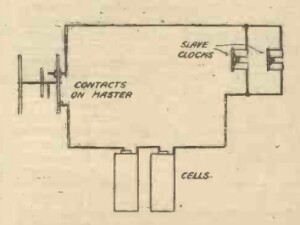 Eighty years ago this month, the October 1942 issue of the British Practical Mechanics
Eighty years ago this month, the October 1942 issue of the British Practical Mechanics
noted that battery clocks were in great demand because of the war. In the event of a cut-off of the electric mains, householders would be without a means of keeping track of time, and the battery clock was a solution. As shown above, you could build a system of clocks for your house. The master clock could be anywhere in the house, and it could be wired to any number of “slave” clocks. Plans for the master clock had appeared in an earlier edition of the magazine, and complete blueprints were available for two shillings. Once the time was set on the master clock, all other clocks in the house would keep accurate time.
 To build the slave clocks, “the first thing to obtain is an old clock.” Most of the innards were removed, leaving only the two cogs behind the face, controlling the minute and hour hands (or “fingers,” as the author called them). At that point comes the task of making a cog wheel with 60 teeth, which “requires some care, but it may be easily made” by cutting a sheet of steel or brass, and then filing out 60 teeth.
To build the slave clocks, “the first thing to obtain is an old clock.” Most of the innards were removed, leaving only the two cogs behind the face, controlling the minute and hour hands (or “fingers,” as the author called them). At that point comes the task of making a cog wheel with 60 teeth, which “requires some care, but it may be easily made” by cutting a sheet of steel or brass, and then filing out 60 teeth.
Once a minute, the mater clock would send a pulse, which would advance the long hand–er, finger–by one minute. The author reported that he powered his system by a battery tucked away, floating on a trickle charger, and that his had been in operation for a few years with no problems.
 The 1942 clock is quite elegant. But of course, today it would be of little practical value, since the cost of an extremely accurate battery operated clock is close to zero, as shown below. But for the person who constructed the 1942 version, I’m sure there was a sense of pride that the modern version can’t deliver.
The 1942 clock is quite elegant. But of course, today it would be of little practical value, since the cost of an extremely accurate battery operated clock is close to zero, as shown below. But for the person who constructed the 1942 version, I’m sure there was a sense of pride that the modern version can’t deliver.
Some links on this site are affiliate links, meaning this site earns a small commission if you make a purchase after using the link.
